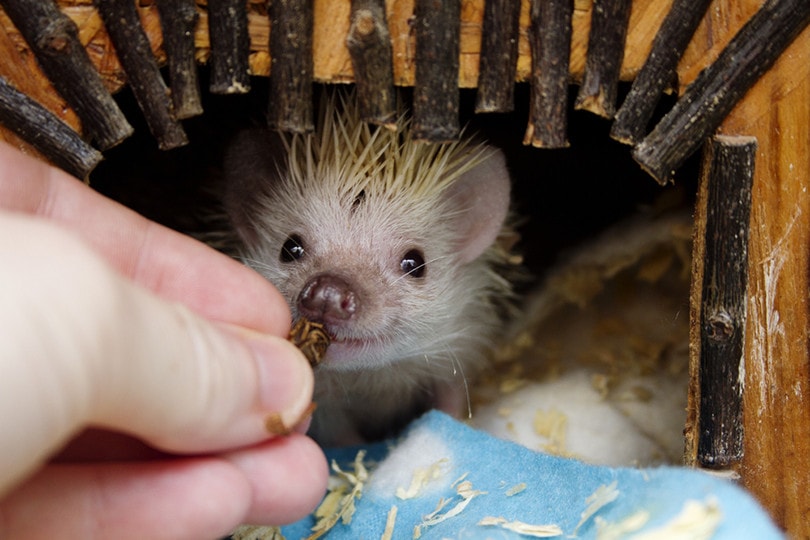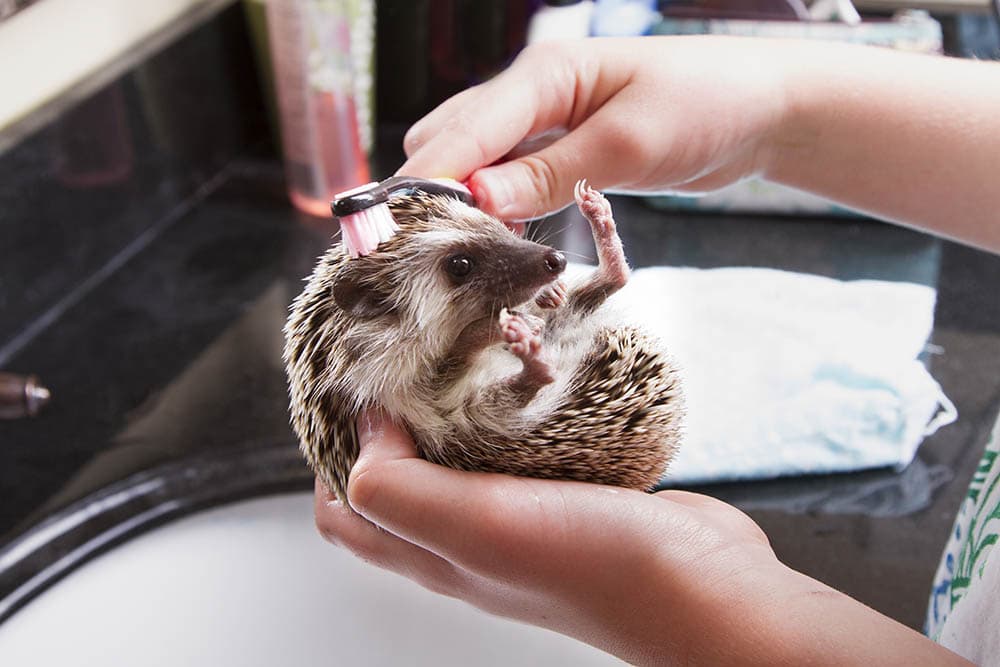
Hedgehogs are one of many exotic animals that have caught the interest of individuals looking for something different in a pet. You must admit it’s a conversation starter. You may wonder why someone would want an animal with a back covered with sharp quills. We’re talking about 5,000 spines on a single hedgehog!
However, hedgehogs wouldn’t have become such popular pets if you couldn’t pick one up and interact with it. Fortunately, it’s possible to handle these animals.
 Learning to Handle a Hedgehog
Learning to Handle a Hedgehog
The essential thing to remember is that slow is the way to go. Sudden movements are likely to startle a hedgehog. Its instinctive response is to curl up in a tight ball. That posture makes those spines an effective strategy against predators. Its underside is covered with fur, but the quills prevent a fox or dog from hurting it without paying a painful price.
The takeaway message is that this position means that it’s not a good time to try and pick up your hedgehog. Interestingly, this animal uses its spines to signal its mood, not unlike a cat. If they are lying flat against the hedgehog’s back, it’s feeling calm. Once they come up, then it’s time to be on your guard. It’s a warning sign that your hedgehog isn’t feeling sociable.
Here’s a great YouTube video for handling hedgehogs
The 3 Tips for First Few Days
In an ideal world, you’ll get your hedgehog from a reputable breeder who understands the importance of handling these animals when they’re young and does so. That early socialization is an excellent icebreaker. Nevertheless, hedgehogs don’t like changes in their world. Even the friendliest animals are going to be stressed moving to a new home with strangers in their midst.

1. Give It Some Space
We strongly urge you to give your hedgehog space during those first few days. Let it get a chance to get the vibe of its new home before you try to handle it. Keep in mind that it’s a prey species that is hardwired to be wary of new things.
2. Play By the Rules
The other essential factor is to play by your hedgehog’s rules. That means handling your pet on its time, not yours. Remember that it’s a nocturnal animal. It’s not going to welcome being picked up if you’ve woken it up from a deep sleep.
3. Let Them Get Used to Your Scent
The next thing is to get your pet used to your scent. Don’t rush the process. Move slowly around your hedgehog. We suggest making these first attempts at picking it up alone to keep the focus on you. While you may have your eyes on the quills, don’t forget that this animal can—and will—bite. Taking your time, in the beginning, will prevent any negative associations your hedgehog will have about being handled.
Let your pet sniff your hands before you think about picking up your pet. Patience is your friend. While your hedgehog will get used to you eventually, we wouldn’t say that these animals are cuddly like a kitten. Of course, don’t forget the magic of treats. They can work wonders for bridging the gap.
Safety Concerns
We’d be remiss if we didn’t include a few words about safety when handling hedgehogs. The quills are reason enough not to get one if you have small children in your home. There’s also a risk of zoonotic diseases or those that are transmittable to humans from animals. The concern with hedgehogs is Salmonella. The CDC cited a problem at the beginning of 2021.
Therefore, if you do succeed in picking up your hedgehog, you should wash your hands afterward and avoid touching your face before you do. It’s another reason to keep the kids away from your pet.
It’s also helpful to get familiar the animal’s history and temperament to know how handle the animal.

History of Domesticated Hedgehogs
Hedgehogs have a long history of domestication, although not necessarily what you may think. While the Romans had them as pets as early as the 4th century BC, hedgehogs also made it to the dinner table—literally! We won’t comment on that aspect of animal husbandry. It’s worth mentioning that the hedgehogs were also pets at this time.
Fast forward to the late 20th century. Hedgehogs took off as exotic pets. However, not everyone welcomed these animals. Many states ban them, including California, Colorado, Georgia, and Hawaii. Unfortunately, it’s a bit more complicated. The two species of hedgehogs you’ll likely find for pets are the Western European Hedgehog and the Four-Toed Hedgehog, also known as the African Pygmy Hedgehog.
Some states distinguish between the two. You may learn that the former is illegal while the latter is all right to own. Arizona, Oregon, and Idaho are three places where you’ll encounter this barrier to having a hedgehog as a pet. The reasons play an indirect role in being able to handle one of these animals.
Behavior and Temperament
The behavior and temperament of the hedgehog figure prominently in the question of how to pick up one. They represent the challenges you’ll face when making this next move to bond with your pet. Hedgehogs are nocturnal. They’ll spend their days sleeping. If you try to handle one during this time, you’ll likely get a less than welcoming reception.
The other thing to remember is that hedgehogs are solitary animals except during mating. They don’t necessarily seek out any kind of companionship other times during the year. The other thing to bear in mind is that these animals are prey species in the wild. That fact comes to the forefront in its temperament. Hedgehogs are naturally wary of new things in their world. That includes you.

 Final Thoughts
Final Thoughts
The way to approach picking up a hedgehog is to take it on the animal’s terms. You shouldn’t rush taking up this pet in your arms. It will likely fight you with you ending up getting pricked. The quills are a defensive mechanism. That means you should avoid doing anything that would make a hedgehog feel threatened. That’s where the spines come into action.
Featured Image Credit: Julia Jane, Shutterstock
 Learning to Handle a Hedgehog
Learning to Handle a Hedgehog





